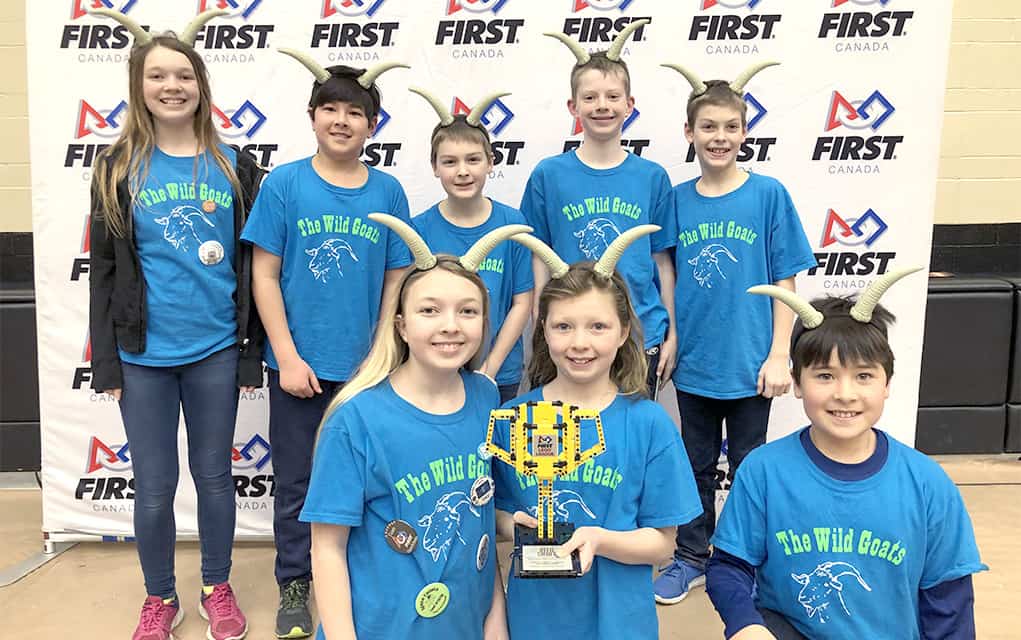The St. Clements Wild Goats FIRST LEGO League team stepped up their game at their first provincial competition this year, snagging the mechanical design award.
“We weren’t expecting that when they announced it; they were so excited and they ran up, high-fived all the judges in a big row in the gym there, and got their picture taken at the end there,” said team coach Jason Jantzi. “It was pretty amazing.”
Eight local kids from Grades 4-8 had been practicing for months in preparation for the competition, the FIRST LEGO League Provincials (West), which took place this past weekend on February 9 at the University of Waterloo. Some 40 teams from across the province came out to compete with their autonomous LEGO Mindstorm-constructed robots. Each group has two minutes and 30 seconds to complete as many tasks with their robot as possible. They have several tries to do so, and their best round counts as their score.
The Wild Goats team competed in previous competitions with their robot, Billy the Goat. They made sure to practice relentlessly beforehand, adding several tweaks and modifications to their robot.
“They had the same robot; they added a few extra missions onto it,” explained Jantzi. “They also added a menu system to make it a little bit faster to implement. The judges were pretty impressed with their original robot design and their menu system.”
The team ended up placing 17/40 in the day-long event, obtaining their best score of 109 in the first round. A team called the Canadian Circadians scored the top spot with 288 points and is the sole team moving on to the world competition.
There were many components to the event including practices, ceremonies, and presentations. Team member Hudson Jantzi says the process was a real learning experience.
“I felt like we learned some pretty good stuff when we were there through working on our robot and presentations,” said Hudson Jantzi. “Our presentation was about growing strawberries in space. We also had another presentation about our robot design, which we won the award in.”
The presentation component covers research problems faced by today’s scientists, challenging team members to come up with a creative solution and present it effectively. It is another component of the FIRST LEGO League along with the robot design.
There was a full house present at the competition, with hundreds of attendees and judges watching the performances. But the group did not let the pressure phase them.
“It’s amazing what they learned,” added Jason Jantzi. “A lot of them knew nothing about robots or programming, so they learned a lot in that aspect. And even for the presentations, having to answer questions on the spot … a lot of members came out of their shell I noticed and were just open to answering questions.”
This was the team’s first year in the FIRST LEGO League team, taking part in a series of competitions. The young members saw the event as a learning experience, and are looking forward to continuing the tradition in the future.
“It’s amazing how much you learn and what you can even apply the next year,” said Jason Jantzi. “Just seeing what some of the other teams did for their projects gave us new ideas of different things to do and how to make ourselves better. I’m pretty sure everyone will be doing it again next year.”
There are two other local FIRST LEGO Teams, the Elmira Space Chickens and the St. Jacobs Super Stingers. It provides an opportunity for team members to bond with one another and other groups in the community, in addition to teaching them programming, problem-solving and public speaking skills.
“It doesn’t even feel like work because they’re having fun,” said Jantzi. “The EDSS team mentored the kids from there, and the Space Chickens team also provided some of the solar panels so they could do other missions – it was good to have them involved. So there’s a lot of camaraderie between the teams. It’s a friendly competition.”
There are four divisions of FIRST, depending on the age group. Other divisions include LEGO League Junior for kindergarten to Grade 4, Tech Challenge for Grades 7-12, then the Robotics Competition for Grades 9-12.
For more information, visit The FIRST Lego League website.









